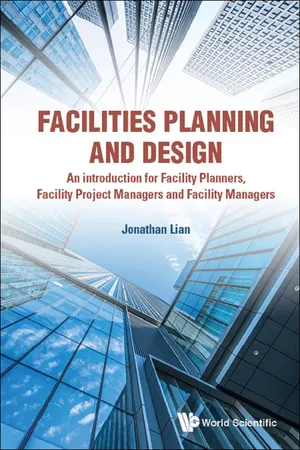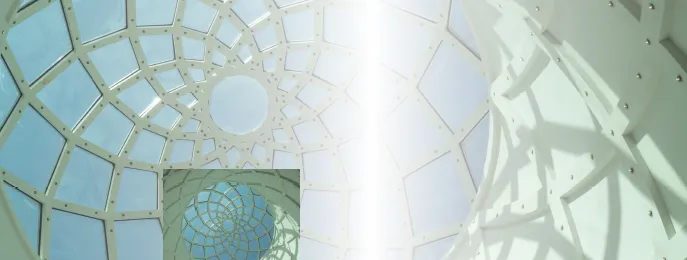![]()
PART 1
Facilities Planning and Design
![]()
CHAPTER 1
Ten Essentials of Facilities Planning and Design
In this chapter, you will learn about the following:
1.Definitions
2.The importance of facilities planning and design
3.The ten essentials that facility managers need to know about facilities planning and design
4.Essential #1a – Understanding the phases in the life of a facility
5.Essential #1b – Knowing the parties who are involved in the development of a building
Essential #1
Understand the phases in the development of a facility and know the parties involved in the development of a building.
1.1Definitions
We will first consider what is facilities planning and design. To do this, we will examine each of the following words in turn: “facilities”, “planning”, and “design”.
Facilities refers to the spaces in the built environment used by people and their organisations. It can range in size from an office unit in a building to an entire building to a campus with multiple buildings. It also includes infrastructure like airports, seaports, land transport structures and utilities.
Planning and design are the first two phases in the development of facilities. This is followed by the building or construction of the facility. Once the facility is completed, it is handed over to the facility manager who will manage it for the rest of its usable life span.
Planning involves making plans to achieve an objective, in this case, the successful completion of a building. Design is the process of translating the objectives and needs of the client into floor plans and drawings that will enable the construction of the building.
1.2Recognising the importance of facilities planning and design
The facility manager is responsible for the work environment, the buildings and the campus that an organisation occupies. Having a strong understanding of facilities planning and design is important because this enables the mission of the organisation through the provision of suitable facilities, improves the performance of the organisation and uses financial resources efficiently.
Facilities (in the form of buildings) enable the mission of the organisation. A poorly designed building will neither be able to serve the users of the building well nor serve its intended function effectively. For example, a poorly laid out shopping centre affects the shopping experience and will have greater difficulty attracting shoppers and tenants. Conversely, a shopping centre that is designed with the shopper’s experience in mind will have a better chance of attracting shoppers and retaining tenants.
Good facilities planning and design enhances the work environment, and a well-planned and designed building can increase the performance of the people and the organisation(s) that occupy it. A poorly designed building affects the productivity of its occupants. For example, in a factory building, careful thought has to be given to the production process so that the layout and location of equipment facilitates and enables workers to work at their highest productivity. In a hotel or MICE (meetings, incentives, conferencing, exhibitions) venue, an example of this is having a central kitchen layout adjacent to the restaurants and meeting spaces to help centralise operations and reduce the amount of space required by reducing redundant kitchen facilities.
Effective facilities planning and design uses financial resources efficiently. Many buildings have a lifespan of 50–100 years. A poorly planned and designed building will cost more to operate and maintain over its lifespan. This will affect the profitability of the organisation occupying the facility. A flexible floor plan allows for reconfiguration of the building as user needs change and maximises the lifespan of the building.
1.3What are the ten essentials that facility managers need to know about facilities planning and design?
According to the International Organisation for Standardisation, facility management is the “organisational function which integrates people, place and process within the built environment with the purpose of improving the quality of life of people and the productivity of the core business”.
Organisations that own large facilities have an in-house team of facility management staff that oversee the operations and maintenance of the facilities. Larger organisations also have staff that oversee the planning and design of the facilities.
In the past, operations and maintenance staff would not be involved in the planning and design phases of the facility. However, there has been increasing recognition that many challenges faced in operating and maintaining facilities could have been avoided if these staff were involved in the planning and design of their facilities rather than just receiving the facility on completion of the construction process. With the knowledge gained in the operation and maintenance of facilities, these staff can provide good feedback for the planning and design of facilities and pre-empt potential operations and maintenance problems.
An organisation typically does not retain in-house design staff so there is a need to hire design consultants to design new buildings. At a minimum, large owner organisations tend to have in-house staff that can act as the single point of contact as the Owner’s Representative (OwnerRep) for the building project. The role and responsibilities of the OwnerRep will be further discussed in Chapter 3. OwnerReps are often in-house staff with experience in facilities planning and design. The number of OwnerReps appointed depends on how much development work the organisation has and whether they prefer to keep this function in-house or outsource it. In some large organisations, the planning and design of facilities are managed by in-house “facility planners” or “facility project managers” that are part of the facilities management department of the organisation.
For the purposes of this book, the term “facility manager” is used to refer to the managers in the owner organisation that oversee one or all of the following functions: operations, maintenance, planning and design.
There are ten essentials that a facility manager needs to know about Facilities Planning and Design. We will introduce them in this chapter and proceed to expand on each point in the remaining chapters of the book. Depending on the size of the organisation and its structure, the various functions described can be done by one person or split up and done by various people.
Essentials #1 to #3
#1. Understand the phases in the development of a facility and know the parties involved in the development of a building.
#2. Recognise that the organisation’s strategic plan drives the need for facilities. The facility master plan should be aligned with the strategic plan.
#3. Understand the role and responsibilities of the Owner’s Representative (OwnerRep) in planning and design. Learn how to manage the selection process for design consultants.
The first three essentials form the foundation of what an owner needs to know about facilities planning and design.
Essential 1 addresses the “What” and “Who” of the complex process of developing facilities. It introduces the various phases in the development of a building and the parties that are involved. This forms a backdrop for the rest of the essentials. Essential 1 will be covered in Chapter 1.
Essential 2 highlights the pivotal role of the organisation’s strategic plan. Facilities must be aligned with the organisation’s strategy. For facilities with large campuses, the facility master plan which outlines the phased long-term development must flow from the strategic plan and be aligned strongly so that the facilities fulfil the organisation’s vision and mission. Chapter 2 covers the various aspects of the organisation’s strategic plan and how this plan translates into the facility master plan.
Essential 3 reminds the reader of the importance of the role which the Owner’s Representative plays in planning and design. In every large organisation that develops facilities, there will be a person with the responsibility for representing the Owner’s interest during the development of the building. This person will be known as the “Owner’s Representative” (OwnerRep) in this book. In organisations that have in-house project management staff, the organisation’s project manager will be the OwnerRep. Chapter 3 discusses the responsibilities of the OwnerRep in all phases of the development project with an emphasis on the planning and design phases. It also discusses how the Owner’s in-house project team can be organised.
Essential 3 also highlights that the key to a successful development project is selecting the right consultants and companies to work with to deliver the project. In this case, the focus is on selecting the design consultants for the design phase of the development project. This process begins with the writing of the design brief which is included in the tendering documents for the Consultancy Services Tender for the project. In public organisations, the tendering process needs to be conducted in a fair and transpa...

